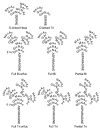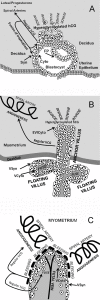New discoveries on the biology and detection of human chorionic gonadotropin
- PMID: 19171054
- PMCID: PMC2649930
- DOI: 10.1186/1477-7827-7-8
New discoveries on the biology and detection of human chorionic gonadotropin
Abstract
Human chorionic gonadotropin (hCG) is a glycoprotein hormone comprising 2 subunits, alpha and beta joined non covalently. While similar in structure to luteinizing hormone (LH), hCG exists in multiple hormonal and non-endocrine agents, rather than as a single molecule like LH and the other glycoprotein hormones. These are regular hCG, hyperglycosylated hCG and the free beta-subunit of hyperglycosylated hCG. For 88 years regular hCG has been known as a promoter of corpus luteal progesterone production, even though this function only explains 3 weeks of a full gestations production of regular hCG. Research in recent years has explained the full gestational production by demonstration of critical functions in trophoblast differentiation and in fetal nutrition through myometrial spiral artery angiogenesis. While regular hCG is made by fused villous syncytiotrophoblast cells, extravillous invasive cytotrophoblast cells make the variant hyperglycosylated hCG. This variant is an autocrine factor, acting on extravillous invasive cytotrophoblast cells to initiate and control invasion as occurs at implantation of pregnancy and the establishment of hemochorial placentation, and malignancy as occurs in invasive hydatidiform mole and choriocarcinoma. Hyperglycosylated hCG inhibits apoptosis in extravillous invasive cytotrophoblast cells promoting cell invasion, growth and malignancy. Other non-trophoblastic malignancies retro-differentiate and produce a hyperglycosylated free beta-subunit of hCG (hCG free beta). This has been shown to be an autocrine factor antagonizing apoptosis furthering cancer cell growth and malignancy. New applications have been demonstrated for total hCG measurements and detection of the 3 hCG variants in pregnancy detection, monitoring pregnancy outcome, determining risk for Down syndrome fetus, predicting preeclampsia, detecting pituitary hCG, detecting and managing gestational trophoblastic diseases, diagnosing quiescent gestational trophoblastic disease, diagnosing placental site trophoblastic tumor, managing testicular germ cell malignancies, and monitoring other human malignancies. There are very few molecules with such wide and varying functions as regular hCG and its variants, and very few tests with such a wide spectrum of clinical applications as total hCG.
Figures






References
-
- Hirose T. Exogenous stimulation of corpus luteum formation in the rabbit: influence of extracts of human placenta, decidua, fetus, hydatid mole, and corpus luteum on the rabbit gonad. J Jpn Gynecol Soc. 1920;16:1055.
-
- Aschheim S, Zondek B. Das Hormon des hypophysenvorderlappens: testobjekt zum Nachweis des hormons. Klin Wochenschr. 1927;6:248–252.
-
- Wide L, Gemzell CA. An immunological pregnancy test. Acta Endocrinol. 1960;35:261–267. - PubMed
Publication types
MeSH terms
Substances
LinkOut - more resources
Full Text Sources
Other Literature Sources
Medical

